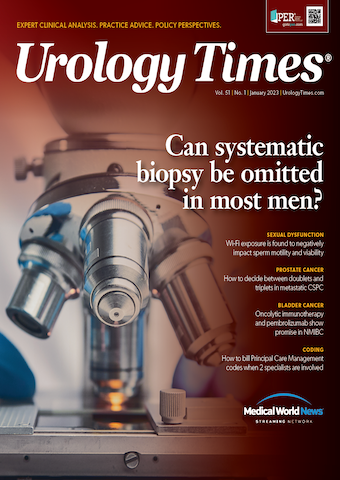Publication
Article
Urology Times Journal
Wi-Fi exposure found to negatively impact sperm quality
Author(s):
Investigators found that mitigation methods such as adding a physical barrier or increasing distance could lessen the harmful effects.
Smartphones that use Wi-Fi connectivity for data transmission have a negative impact on semen quality in men by decreasing sperm motility and viability, according to findings from a recent study conducted by investigators at Desai Sethi Urology Institute at the University of Miami’s Miller School of Medicine in Florida.1
The authors examined the effect of close contact with wireless-spectrum (4G, 5G, and Wi-Fi) radiofrequency electromagnetic radiation (RF-EMR) on sperm motility and viability, as well as whether negative effects can be mitigated by introducing a physical barrier or distance.
The study was conducted in 2 parts, with investigators collecting semen samples from male patients aged 25 to 35 years in both. Samples were collected via masturbation after an abstinence period of at least 2 days. A current-generation Apple iPhone with the most recent software was used for all experiments.
The primary end point of the study was the effect of continuous RF-EMR exposure on sperm parameters, which included total motility, progressive motility, and viability. Secondary endpoints were an evaluation of methods for mitigating the effects of RF-EMR on semen quality.
In the first phase of the study, investigators analyzed the impact of exposure to 4G, 5G, and Wi-Fi data transmission on the semen samples of 9 men. Semen went through a process of standard analysis before equivalent volumes of semen were divided into each of five 24-well plates. One control plate was not exposed to cell phone–generated radiation and was left in ambient conditions whereas the other plates were either exposed to 4G, 5G, cellular network calling for 6 hours, or Wi-Fi calling via a WhatsApp voice call.
The authors found no negative impact of 4G, 5G, or cellular network exposure on semen quality based on the 3 parameters analyzed. Data did show a decrease in sperm motility and viability for the samples exposed to Wi-Fi. Total motility was 41% for the Wi-Fi–exposed group and 50% for the control group (P = .030), progressive motility was 38% for the Wi-Fi group and 50% for the control group (P = .024), and sperm viability was 47% for the Wi-Fi group and 60% for the control group (P = .003).
Given that Wi-Fi was found to have negative impacts on semen quality, the authors investigated potential ways to mitigate Wi-Fi’s harmful effects. In this second phase of the study, investigators analyzed the impact of introducing a physical barrier and distance from the radiation source on semen parameters, and 18 new patients were recruited. Semen samples were again collected, and they were divided into each of four 24-well plates with each having equivalent seminal volume.
One plate was not exposed to cellphone-generated radiation whereas each of the others was exposed to Wi-Fi calling via a WhatsApp voice call for 6 hours with varying degrees of exposure throughout. The 3 plates received either direct exposure (by placing the cellphone directly on top of the plate), barrier coverage (involving placing a hard-shell plastic case on the cell phone), or distance separation (involving placing the phone without a case 4-in distance above the plate).
Direct Wi-Fi exposure led to a decrease in all 3 parameters measured as compared with the control sample. When a cellphone case was in place, total and progressive motility were preserved, although sperm viability decreased to 42% in comparison with 65% for the control group (P =.004). The viability level seen from the case-covered cellphone sample was an increase when compared with 30% (P < .001) from the sample with direct exposure.
Adding a 6-in distance between the sample and cellphone exposure resulted in a decrease in total motility, from 35% compared with 56% for the control sample (P =.022) but was an increase as compared with 17% for direct exposure (P < .001). Progressive motility also decreased, being 31% compared with 54% in the control group (P = 0.013), yet was an increase when compared with 12% for direct exposure (P < .001). Viability in the distance sample also decreased to 40.5%, compared with 65% for the control sample (P = .002) and increased when compared with 30% for direct exposure (P =.001).
In explaining the impact of environmental factors such as distance from cell towers, the authors wrote, “We posit that a greater distance from the wireless router results in a need for more cellphone power, which may lead to greater heat production and result in negative effects on sperm motility and viability. Mitigation measures such as use of a cellphone case and increasing the distance between the cellphone and the sperm sample lessened the effects.”
Reference
1. Chu KY, Khodamoradi K, Blachman-Braun R, et al. Effect of radiofrequency electromagnetic radiation emitted by modern cellphones on sperm motility and viability: an in vitro study. Eur Urol Focus. Published online November 12, 2022. Accessed December 9, 2022. doi: 10.1016/j.euf.2022.11.004

Newsletter
Stay current with the latest urology news and practice-changing insights — sign up now for the essential updates every urologist needs.
























